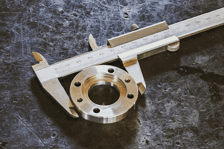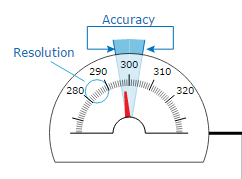 Accuracy and resolution both appear in specifications for our SNAP analog modules. But what do they mean, exactly?
Accuracy and resolution both appear in specifications for our SNAP analog modules. But what do they mean, exactly?
Accuracy
Let's start with accuracy, which is pretty easy to understand. Accuracy is how close a measured value is to reality, to the true quantity of what is being measured.
For example, if the accuracy of an analog voltage input like our SNAP-AIV is 5 mV (0.005 V), that means that any value the input reports will be within +/- 0.005 V of the actual voltage it receives.
Resolution
Resolution, on the other hand, is the smallest increment the system can measure—the smallest step of measurement. For example, the SNAP-AIV has a resolution of 0.4 mV (0.0004 V), so the values it measures are reported in increments of 0.0004 V, like this:
Volts
0.0000
0.0004
0.0008
0.0012
etc.
So, for example, you would never see a value of 0.0003 V from this input. The values will be in steps of 0.0004.
 Why? Values have to be in steps because the module converts the analog signal it receives to a digital one in order to send it to the brain or controller. Digital data, of course, consists of a series of on/off bits; these are the "steps" of resolution.
Why? Values have to be in steps because the module converts the analog signal it receives to a digital one in order to send it to the brain or controller. Digital data, of course, consists of a series of on/off bits; these are the "steps" of resolution.
Here's an interactive demo explaining accuracy and resolution. Plug your own specs into the calculator and see how one can affect the other.
Why two specs?
When you look at the SNAP-AIV specifications you'll notice we show two specs for accuracy and two for resolution. That's because for each of the points on this module you can select a point type of either -10 to +10 VDC input (the default) or -5 to +5 VDC input. The accuracy and resolution change depending on which point type you've selected.
Get the accuracy and resolution you need
Some applications require greater accuracy, or finer resolution. Some don't. So choose your sensors and your SNAP I/O modules based on what your specific application needs. Read the specs and be sure to contact us if you have any questions.

